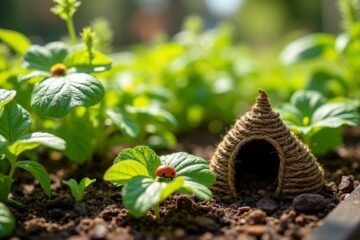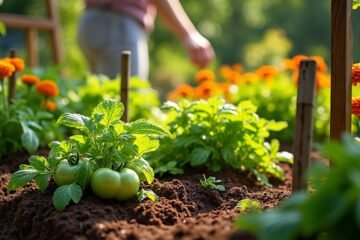Creating the perfect soil mix for your raised bed garden is like baking a scrumptious cake! Start with equal parts rich compost and quality topsoil for nutrients and drainage, then sprinkle in some perlite or coarse sand to help those roots breathe, just like a good pair of shoes! Don’t forget to enrich it with local leaf mold for harmony with your native plants. Intrigued? Stick around, and I’ll share more delightful tips for your gardening adventure!
Organic Vegetable Garden Soil Mix

When you’re digging into raised bed gardening, having the right soil mix is like finding the perfect recipe for a delicious cake—it’s essential! To create your organic vegetable garden soil mix, start by blending equal parts of rich compost and high-quality topsoil. The compost benefits are tremendous—it not only feeds your plants but also enhances soil drainage like magic! You don’t want your veggies sitting in a muddy mess, do you? Adding perlite or coarse sand can really boost drainage, ensuring roots breathe easily while soaking up nutrients. Think of your garden as a gourmet restaurant; every ingredient matters! So why not whip up a fantastic, innovative soil mix that’ll have your plants thriving and growing like you’ve got a green thumb up your sleeve?
Herb Garden Soil Blend
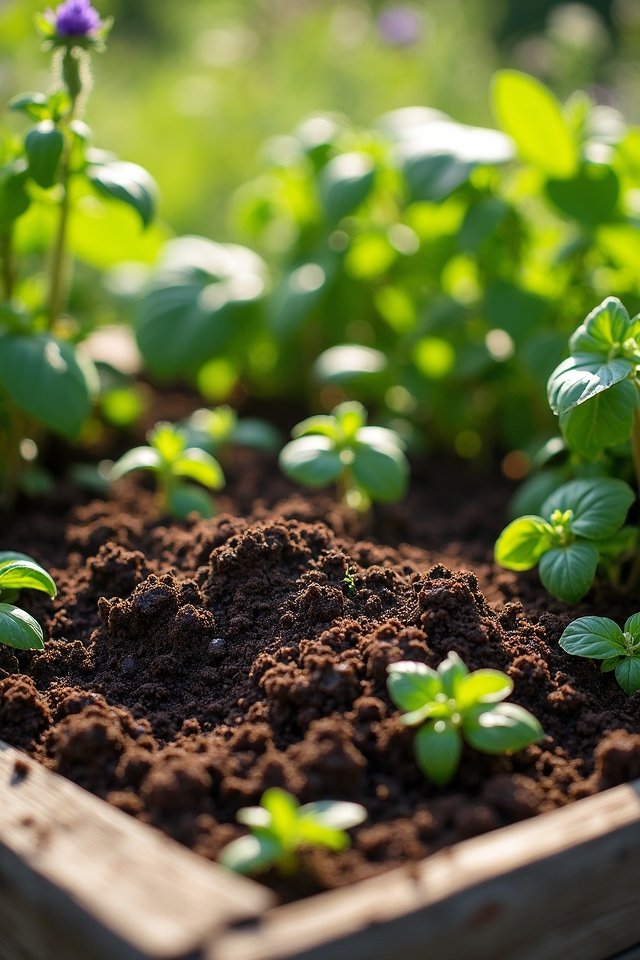
To craft a delightful herb garden soil blend, you’ll want a mix that not only nurtures your plants but also provides them with a cozy home! Start with rich, loamy soil as your base—it’s like a comfy mattress for those leafy greens! Toss in organic compost to boost soil nutrients and that earthy aroma will have you smelling success. Don’t forget a splash of perlite or vermiculite for drainage; herbs hate soggy feet! A sprinkle of crushed eggshells can offer calcium, turning your garden into a nutrient powerhouse. Want to spice things up? Try adding some crushed granite or limestone for texture. Your herbs will thrive, and you’ll be harvesting in no time—who doesn’t want fresh basil on pasta, right?
Flower Bed Soil Composition
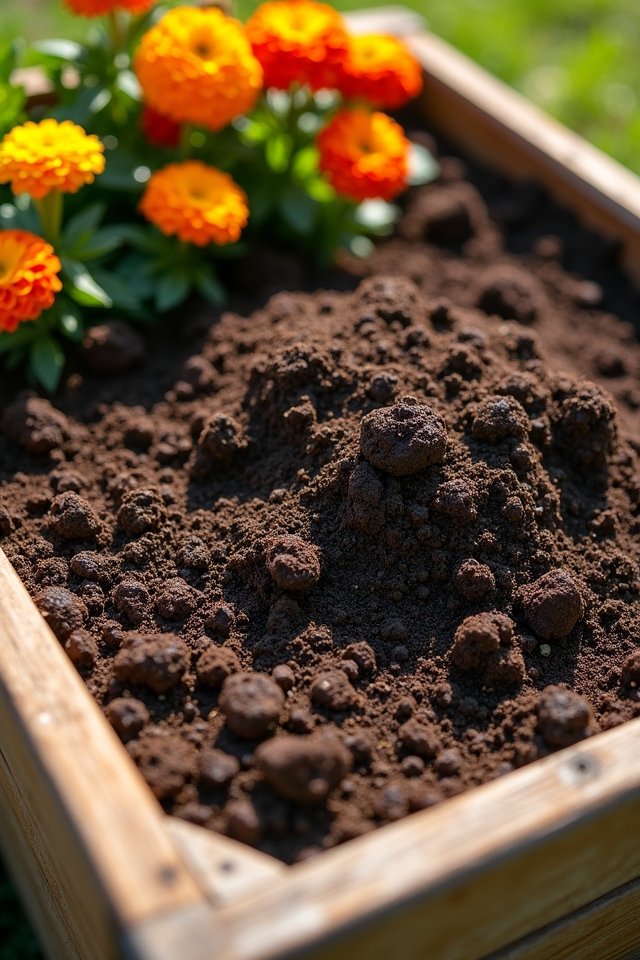
Creating the perfect flower bed soil composition is like preparing a gourmet feast for your blooms! You need to mix rich ingredients that supply essential flower bed nutrients while ensuring proper soil drainage. Here’s how to spice things up:
- Organic compost: It’s the secret for lively growth!
- Peat moss: A moisture-retaining superstar!
- Perlite or vermiculite: For that dreamy aeration!
- Bone meal: A delicious boost of phosphorus!
- Coconut coir: A sustainable way to hold moisture!
Aim for a balance of these components to create a hospitable environment for your flowers. Just like a chef perfects a recipe, you’ll find that ideal flower bed soil brings vibrant colors and delightful fragrances into your garden. Get ready to watch your blooms thrive!
Native Soil Amendments for Raised Beds

While you might think that raised beds demand only fancy soil blends, embracing native soil amendments can be a game changer! Picture your garden thriving on the incredible native soil benefits—it’s like giving your plants a warm hug from Mother Nature! Using soil amendment techniques like mixing in local compost, leaf mold, or even crushed granite adds essential nutrients and textures. Just imagine that rich, earthy scent as you dig in! Rather than battling against the local soil, partner with it—are there better flavors than those vibrant veggies grown in harmony with their roots? By choosing what’s from your own backyard, you create a resilient ecosystem. So why not experiment with these innovative ideas, and watch your garden flourish?!
Potting Soil vs. Raised Bed Soil Mix
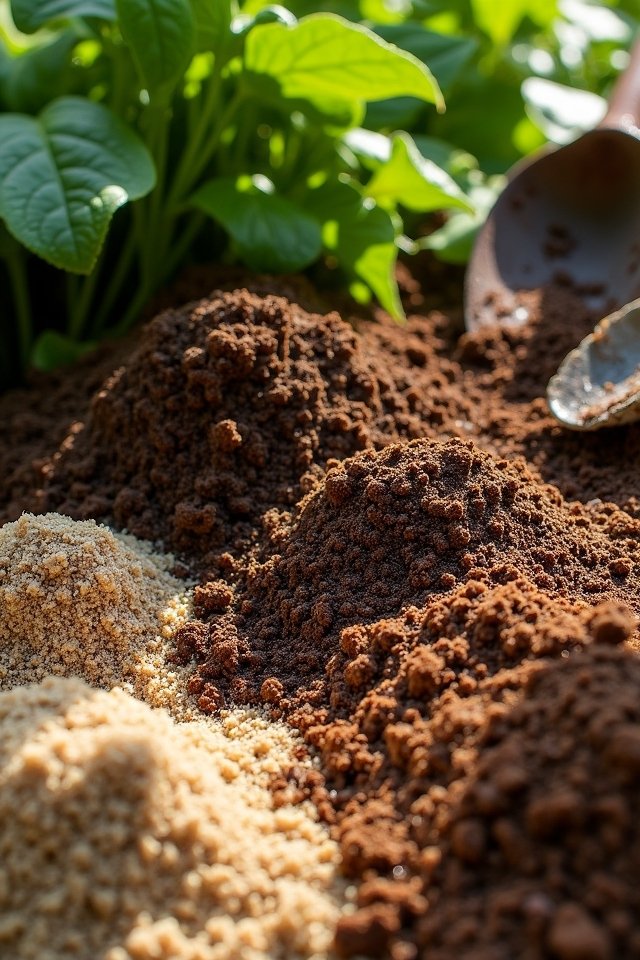
Soil is truly the lifeblood of your garden, isn’t it? Choosing between potting soil and raised bed soil mix can feel like picking a favorite child. They each have their perks!
Potting soil benefits include:
- Lightweight structure for easy handling
- Fantastic drainage for containers
- Nutrient-rich for potted plants
- Ready-to-use mix with no fuss
- Ideal for indoor and balcony gardening
On the other hand, raised bed advantages shine through in:
- Enhanced drainage, perfect for veggies
- Personalized blends tailored to your plants
- Greater soil volume for root development
- Majestic ecosystems thriving in your garden
- Long-lasting fertility with careful layering
Ultimately, it’s all about matching your gardening style with your soil choice! Which one will you dig into?
Frequently Asked Questions
How Often Should I Refresh My Raised Bed Soil Mix?
Imagine your garden soil’s like a fine wine—it needs time to mature, but it also requires a revitalizing sip every once in a while! You should refresh your raised bed soil mix about once a year or when soil testing methods show nutrient depletion. Adding organic matter like compost works wonders! Think of it as giving your plants a nutritious meal—after all, they deserve a tasty feast, don’t they?
Can I Use Homemade Compost in My Soil Mix?
You can use homemade compost in your soil mix. It’s like nature’s multivitamin for your plants, packed with soil nutrients that help them thrive. Just imagine tossing in some rich, crumbly compost after a rainy day—it smells earthy and fresh! Mix it well with your soil, and watch your garden burst with life! Who knew a little homemade magic could lead to a flourishing oasis right in your backyard? Exciting, isn’t it?
What Is the Ideal Ph Level for Raised Bed Soil?
The ideal soil pH for your raised bed’s success can be like the secret ingredient in your favorite recipe! Generally, it should be around 6.0 to 7.0, which is perfect for most plants. You can use simple testing methods, like pH kits or strips. So, grab one, test your soil, and watch your plants thrive! Remember, healthy soil means healthy yields—like a garden bursting with vibrant colors and delicious flavors!
Are There Any Plants That Shouldn’t Be Grown in Raised Beds?
You might be surprised, but not all plants thrive in raised beds! While root vegetables like carrots love the extra soil warmth, you shouldn’t plant heavy-duty veggies like corn or squash. They need tons of space and might just feel cramped! Imagine them tossing and turning, wishing for room—poor things! Instead, try companion planting with smaller herbs or salad greens. They’ll feel right at home, and they’ll play nicely together in your vibrant garden!
How Do I Prevent Pest Infestations in Raised Bed Gardens?
Did you know that 50% of gardeners face pest issues each year? To keep those pesky critters at bay, adopt organic solutions! Start by introducing ladybugs; they’re like tiny superheroes for your plants. You can also sprinkle diatomaceous earth around your beds—it’s like creating a fortress! Mulch with garlic or peppermint, too; they emit scents pests hate. Regularly inspect your plants, and don’t be shy to toss an intruder out! Happy gardening!
